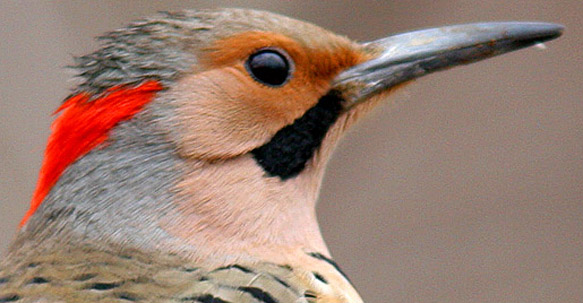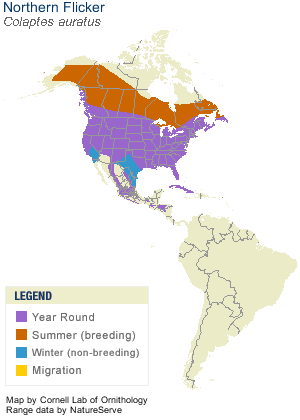
Northern Flicker
 The Northern Flicker is a large, brown woodpecker with a gentle expression and handsome black-scalloped plumage.
The Northern Flicker is a large, brown woodpecker with a gentle expression and handsome black-scalloped plumage.
Keys to identification
Typical Voice
[audio:http://backyardnaturalist.ca/wp-content/uploads/2011/07/373A.mp3|titles=Northern Flicker Call]
-
Size & Shape
Flickers are fairly large woodpeckers with a slim, rounded head, slightly down curved bill, and long, flared tail that tapers to a point. Flickers are about 12.5 inches in length with a wingspan of 20 inches.
-
Color Pattern
Flickers appear brownish overall with a white rump patch that’s conspicuous in flight and often visible when perched. The undersides of the wing and tail feathers are bright yellow, for eastern birds, or red, in western birds. With a closer look you’ll see the brown plumage is richly patterned with black spots, bars, and crescents. All male flickers have a mustache. Easterns have a black mustache, and westerns sport a red one. Females have similar markings to the male, but they lack the mustache.
-
Behavior
Northern Flickers spend lots of time on the ground, and when in trees they’re often perched upright on horizontal branches instead of leaning against their tails on a trunk. They fly in an up-and-down path using heavy flaps interspersed with glides, like many woodpeckers.
-
Habitat
Look for flickers in open habitats near trees, including woodlands, edges, yards, and parks. Flickers feed on insects, berries and weed seeds. Male and female flickers work together to excavate nesting cavities in dead trees, utility poles and fence posts. Lays six to eight white eggs.
-
Fact
Although it can climb up the trunks of trees and hammer on wood like other woodpeckers, the Northern Flicker prefers to find food on the ground. Ants are its main food, and the flicker digs in the dirt to find them. It uses its long barbed tongue to lap up the ants.